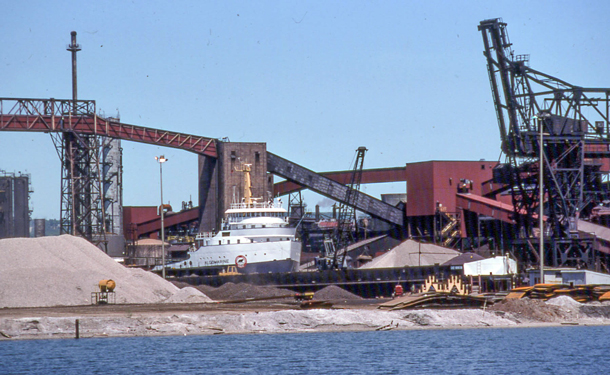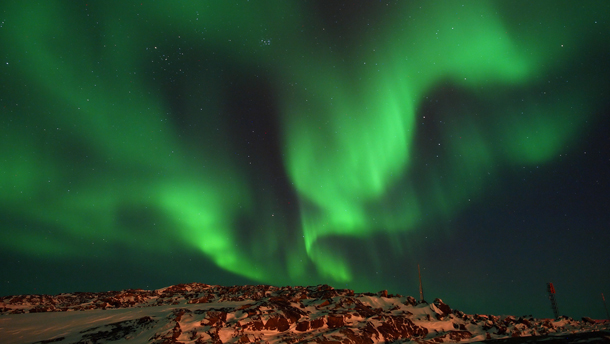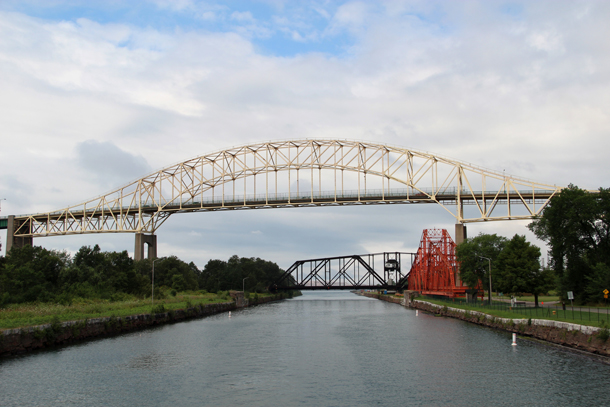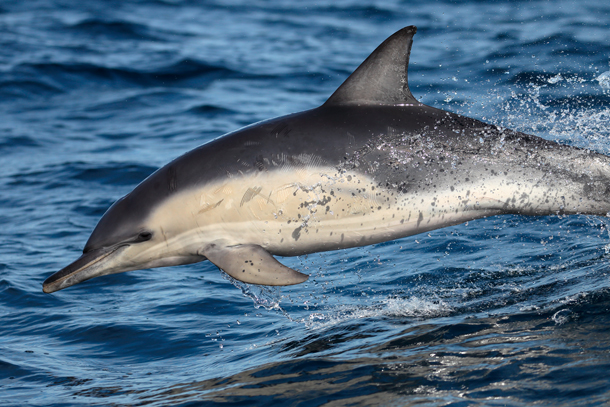Beyond the Headlines
Air Date: Week of April 10, 2020

A steel mill in Sault Ste. Marie, Ontario has emitted high levels of carcinogenic pollutants on both sides of the Canada-United States border. (Photo: David Wilson, Flickr, CC BY 2.0)
This week Peter Dykstra joins Host Steve Curwood to take a look at a growing ozone hole in the Arctic. Then the two discuss attempts to build a ferrochrome plant in the US-Canada border town of Sault Ste. Marie, which has already been impacted by polluting industries. In the history vaults this week: the 30-year anniversary of Star-Kist’s announcement it would no longer buy and sell tuna that could harm dolphins.
Transcript
CURWOOD: It's living on Earth, I'm Steve Curwood.
It's time now to take a look beyond the headlines. And to do that we talk to Peter Dykstra. Peter is an editor with Environmental Health News that's ehn.org and dailyclimate.org. On the line now from Georgia, Atlanta. Hey there, Peter, what's going on?
DYKSTRA: Hi, Steve, I want to start talking about something that sounds like really bad news. It's not good news, but it's not as bad as we might think.
CURWOOD: Okay, not as bad as we might think, go on.
DYKSTRA: In the journal Nature, scientists have reported that there is an ozone hole over the Arctic. This is only the third time there's been an actual ozone hole since we started measuring. The other two are in 1997 and 2011. By the time this one is done, the scientists think it's going to be the biggest ever.
CURWOOD: So you're saying it's not such horrible news? Because why?

The Boreal Northern Lights in the Arctic Sky. The newly discovered ozone hole in the Arctic was formed by a strong polar vortex, leading to freezing temperatures in parts of the atmosphere. (Photo: Fiona Paton, Flickr, CC BY NC ND 2.0)
DYKSTRA: Because since the Montreal Protocol, the treaty on ozone depleting chemicals came into effect in the 1980's the ozone hole at the South Pole and ozone conditions at the North Pole have very gradually begun to repair themselves. And one of the reasons that we had this massive international agreement that resulted in environmental improvement is that it was supported by two conservative icons in world politics, Ronald Reagan and Margaret Thatcher.
CURWOOD: Well, conservatives can be conservationists as well.
DYKSTRA: If they want to be.
CURWOOD: Hey, what else do you have for us this week, Peter?
DYKSTRA: Well, at the EHN page, we have a story from Hilary Beaumont. It's about a pollution problem on the US Canadian border. The town of Sault Ste. Marie, half of Ontario half across the river in Michigan. There's a big polluter on the Canadian side Algoma Steel, there are plans to build what's called a ferrochrome plant to make chromium on the American side. The waste from these plants has included hexavalent chromium, it's a toxic material that's a known cancer causer. And in this case, it's in an area where there is a cancer cluster. And the company says this plant will be cleaner than other hexavalent chromium sites in the past, but residents are concerned.

Picture of Sault Ste. Marie International Bridge which connects two cities by the same name. It has a long history of steel and chromium operations. (Photo: CMH2315FL, Flickr, CC BY NC 2.0)
CURWOOD: Well, that hexavalent chromium is the carcinogen at the center of the Erin Brockovich movie, right?
DYKSTRA: Well, you're absolutely right. But here's the thing. There aren't that many major Hollywood releases about the environment. And hexavalent chromium is actually at the center of two of them. Erin Brockovich and also a civil action best selling book that became a hit movie. That one is about a tannery site in Woburn, Massachusetts. There's also an old tannery site at the Sault Ste. Marie Superfund area, and in the Canadian and Michigan location. The’re astronomic cancer rates on both sides of the border, including those linked to the steel mill.
CURWOOD: So how do folks feel about this?
DYKSTRA: Well, a lot of folks feel that they've been a sacrificed zone to industry already, there's a lot of mistrust about this new ferrochrome plant coming in. The plant promises to provide 300 jobs if it's built. It's an economically struggling region. A lot of residents are saying they already deal with pollution and cancer. So at what cost are those 300 jobs going to come?
CURWOOD: Excellent question to ask. All right, Peter now's the time that we turned a look back in history and I'm wondering what you're looking at today.
DYKSTRA: Yeah, here's something that I looked at, and it's really hard to believe this is 30 years ago already. But on April 12 1990, StarKist, the tuna company subsidiary of Heinz foods, announced that it would no longer buy and sell tuna that's caught by methods that also cause the deaths of thousands of dolphins in purse seine nets.
CURWOOD: Yes, the birth of the dolphin safe tuna.
DYKSTRA: Yeah, StarKist was a pioneer. The reason that they were a pioneer is that their executives were swayed by video shot by an activist named Sam LaBudde. He crude aboard a tuna sauder as a cook, basically another movie titled sleeping with the enemy almost and he videotaped dozens of dolphin carcasses being hauled in with the tuna catch. It appalled people, it turned the corner for this major tuna processor and Sam LaBuddie's courage won him the Goldman Environmental Prize in 1991.

Purse Seine fishing methods are dangerous for dolphins and often result in their unintended deaths. The 1990 Dolphin Protection Consumer Information Act resulted in the “dolphin-safe” labeling campaign, which requires independent observers aboard tuna fishing boats to ensure dolphins were not being killed during the tuna harvest. While not completely successful, there has been a decrease in dolphin deaths while tuna fishing. (Photo: Ed Dunens, Flickr, CC BY 2.0)
CURWOOD: And really struck a blow for using a clandestine video but wouldn't you say this was literally at the risk of his own life?
DYKSTRA: It was one of the most courageous individual acts of environmental activism in history. And it also taught a lesson about using video.
CURWOOD: All right, thank you, Peter. Peter Dykstra, is an editor with Environmental Health News as ehn.org and dailyclimate. org. We'll talk to you again real soon.
DYKSTRA: Okay, Steve, thanks a lot. Talk to you soon.
CURWOOD: And there's more about these stories on the living on earth website at loe.org.
Links
Read more about the study on the big rare ozone hole opening in the Arctic
Living on Earth wants to hear from you!
Living on Earth
62 Calef Highway, Suite 212
Lee, NH 03861
Telephone: 617-287-4121
E-mail: comments@loe.org
Newsletter [Click here]
Donate to Living on Earth!
Living on Earth is an independent media program and relies entirely on contributions from listeners and institutions supporting public service. Please donate now to preserve an independent environmental voice.
NewsletterLiving on Earth offers a weekly delivery of the show's rundown to your mailbox. Sign up for our newsletter today!
 Sailors For The Sea: Be the change you want to sea.
Sailors For The Sea: Be the change you want to sea.
 The Grantham Foundation for the Protection of the Environment: Committed to protecting and improving the health of the global environment.
The Grantham Foundation for the Protection of the Environment: Committed to protecting and improving the health of the global environment.
 Contribute to Living on Earth and receive, as our gift to you, an archival print of one of Mark Seth Lender's extraordinary wildlife photographs. Follow the link to see Mark's current collection of photographs.
Contribute to Living on Earth and receive, as our gift to you, an archival print of one of Mark Seth Lender's extraordinary wildlife photographs. Follow the link to see Mark's current collection of photographs.
 Buy a signed copy of Mark Seth Lender's book Smeagull the Seagull & support Living on Earth
Buy a signed copy of Mark Seth Lender's book Smeagull the Seagull & support Living on Earth

